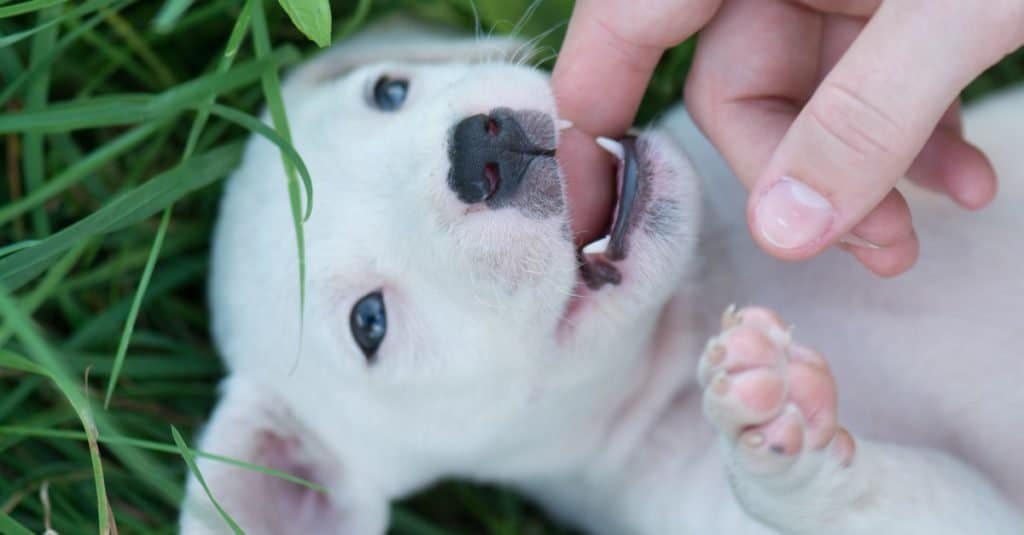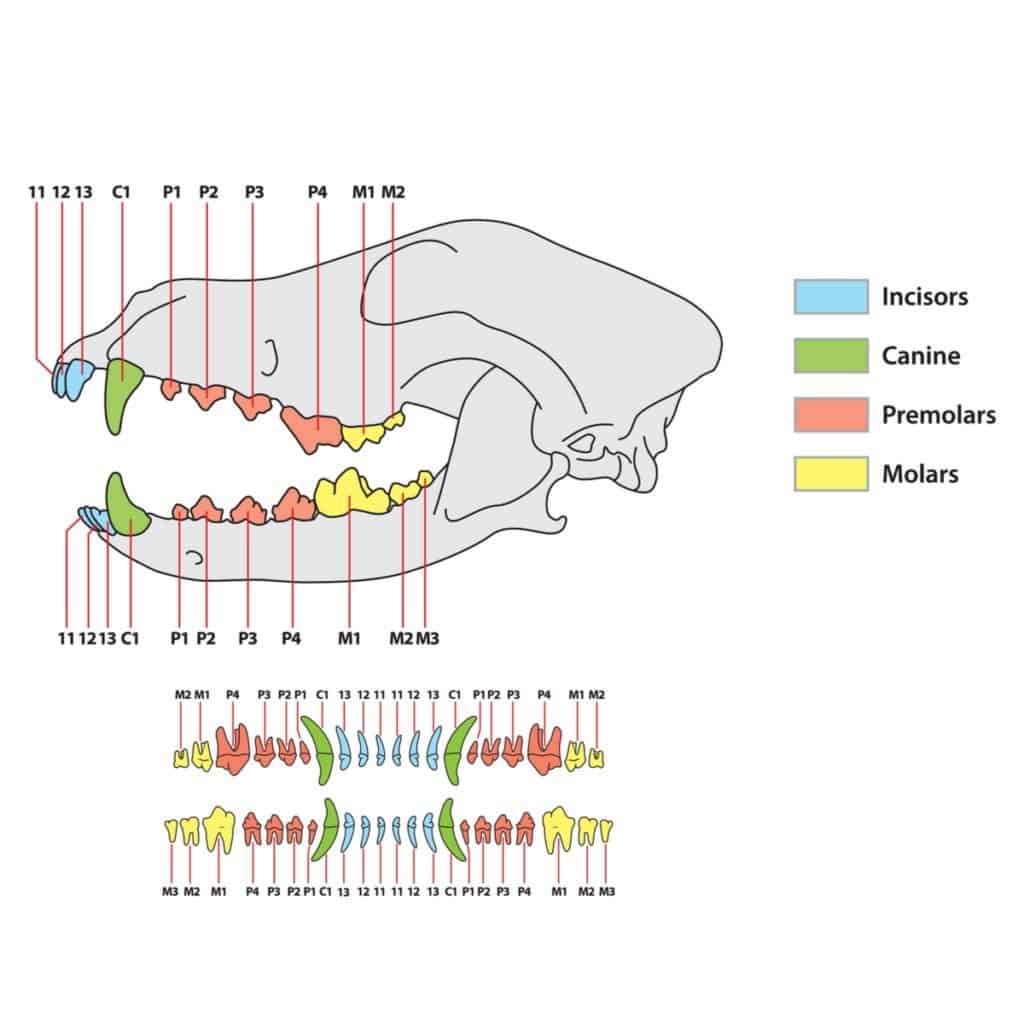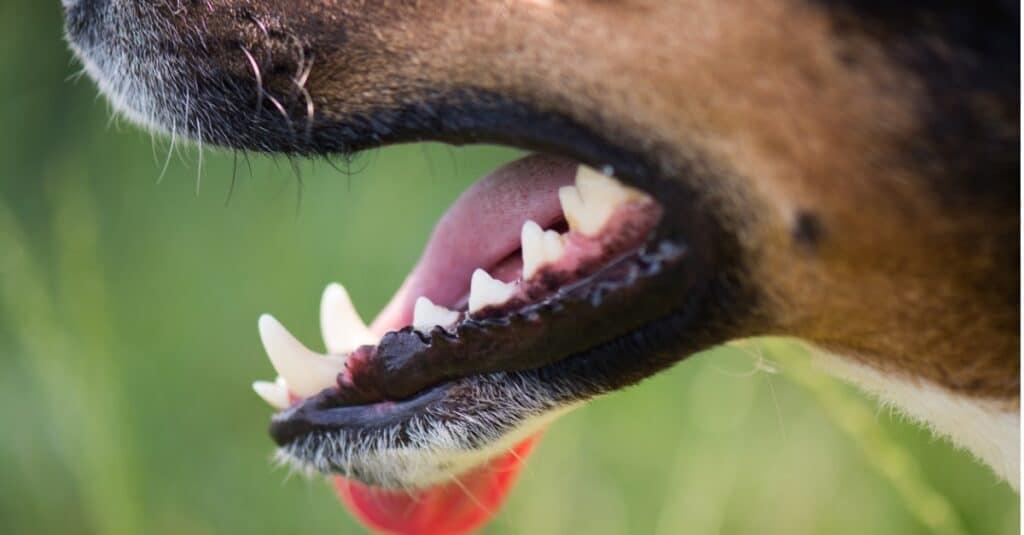Dogs are well known as being man’s best friend and have been faithfully by our sides for centuries. They are highly intelligent and can fulfil a range of different roles – loyal companions, guidance dogs, rounding up livestock, search and rescue dogs, police dogs, and many, many more. Dogs can be seen in all different shapes and sizes – large or small, long haired or short – but the one thing they all have in common is their teeth. All dogs have two sets of teeth in their lives, and they all have the same number of teeth. Join us as we discover everything you need to know about dog teeth.
Dog Milk Teeth
When dogs are born they don’t have any teeth, and it’s not until they’re around 3 weeks old that their first milk teeth begin to appear. Puppies have 28 milk teeth, also known as deciduous teeth. They have 14 upper teeth and 14 lower teeth – 4 canine, 12 incisors, and 12 premolars. Dogs don’t have molars in the puppy stage. The first tooth to appear is usually a canine tooth – these are the ones that are often known as “fangs”. The rest of the milk teeth usually appear by the time the puppy is 3 to 5 months old.
All puppies go through a teething period when their milk teeth are erupting and then when their adult teeth push out their milk teeth. This is because their milk teeth are often extremely sharp and this process can be painful for them. During this phase puppies chew on their toys (and things they’re not supposed to) to try to relieve the discomfort that they are feeling. It’s not uncommon for puppies to drool a lot while they are teething. This is perfectly normal as it’s a result of them reacting to the pain in their gums and also because of all the extra chewing they’re doing. However, although chewing helps puppies when they’re teething, it’s important not to let them get into the habit of nipping and biting.

Puppies often chew more when they are teething due to their new teeth erupting
©llaszlo/Shutterstock.com
Dog Adult Teeth
Although dogs only have 28 milk teeth, they actually have far more adult teeth. Adult dogs have 42 teeth in total – 22 on the bottom and 20 on the top. Adult teeth begin to erupt between 3 and 7 months of age and eventually push out the milk teeth. Dogs have four types of teeth and each serves a unique function when a dog is eating.

Adult dogs have 42 teeth in total.
©Rainer Lesniewski/Shutterstock.com
Incisors
Incisors are the teeth right at the front of a dogs mouth and there are six upper and six lower incisors. These are used for grasping or scraping food – such as scraping meat from a bone. Dogs also use these teeth to groom themselves by nibbling at themselves to remove parasites from their coats. Just like with the milk teeth, incisors are often some of the first adult teeth to erupt.
Canines
Canine teeth are the long, pointy (and sharp) teeth that are often described as “fangs”, although they also have a curved appearance. There are two upper and two lower canine teeth and these are used for tearing food. Dogs also often use their canine teeth for holding onto toys or bones. These teeth usually erupt between 5 and 6 months old and only have one root.
Premolars
Premolars are located behind the canines and are used for chewing food with. This is why dogs often chew bones or treats with the side of the mouth – because it’s where their chewing teeth are located. They have 8 premolars on their top jaw and 8 on the bottom. These usually appear between 4 and 6 months old and each premolar has one or two roots holding it firm.
Molars
Molars are also used for chewing and grinding food down into smaller pieces and they actually look pretty similar to premolars. However, molars are the teeth that dogs use for breaking down kibble and other tough, dry food. They are found behind the premolars and are set the furthest back in the jaw. Dogs have 6 molars on their upper jaw but only 4 on the bottom. They erupt between 4 and 7 months and there are between one and three roots per molar.

Dogs have four types of teeth and they all serve a unique purpose when they’re eating
©iStock.com/betyarlaca
Dog Dental Problems
Sometimes dogs can develop dental problems, and the most common problem is a build up of plaque. Plaque builds up on teeth and can eventually lead to gum disease, infected teeth, or even tooth loss. However, the easiest way to prevent this is to regularly brush your dogs teeth. Therefore, it’s a good idea to get them used to having their teeth brushed when they’re still a puppy as it can prevent major problems later in their life.
Another problem that can sometimes occur in dogs is persistent teeth. Persistent teeth is when the milk tooth does not fall out even when the adult tooth has begun to erupt. Persistent teeth can lead to overcrowding of teeth, or even cause the adult tooth to grow down into an abnormal position as the milk tooth is still in it’s intended place. If this happens then it can cause dogs to have an abnormal bite which can cause problems when eating. Therefore, persistent teeth should be discussed with a vet as they may need to be removed to prevent further problems. Persistent teeth are most common in smaller breeds such as Yorkshire terriers and Chihuahuas.
Quite often the phrase “retained teeth” is used to describe what is actually persistent teeth. Retained teeth is when the milk tooth is still present but the adult tooth has not erupted when it should have. However, these cases are rare, which is why the term is often confused with persistent teeth.
The photo featured at the top of this post is © llaszlo/Shutterstock.com
Ready to discover the top 10 cutest dog breeds in the entire world?
How about the fastest dogs, the largest dogs and those that are -- quite frankly -- just the kindest dogs on the planet? Each day, AZ Animals sends out lists just like this to our thousands of email subscribers. And the best part? It's FREE. Join today by entering your email below.
Thank you for reading! Have some feedback for us? Contact the AZ Animals editorial team.







